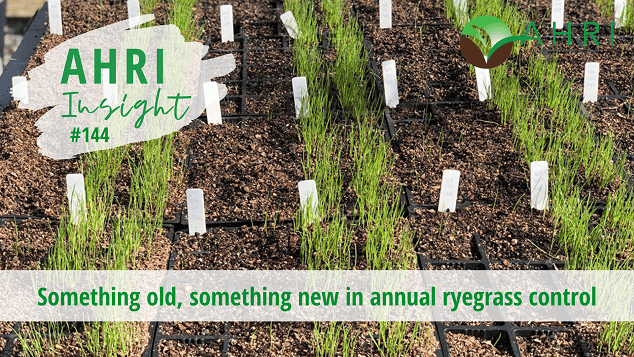
IT’s a quaint tradition that many brides follow – “Something old” represents continuity with the past and “Something new” offers optimism for the future. “Something borrowed” passes on another’s secrets for success and “Something blue” represent key features of a solid relationship. Finally, “A sixpence in your shoe” for prosperity.

“Something old, something new, something borrowed, something blue and a sixpence in your shoe.”
With the release of several new modes of action and chemical formulations, it is helpful to first consider how these ‘new’ chemicals might revive some ‘old’ chemistry. Some herbicide resistant learnings can be ‘borrowed’ and used to build a solid or ‘blue’ stewardship program for each farm, with a ‘sixpence in your shoe’ ensuring the best weed control bang for your buck when using more expensive products.
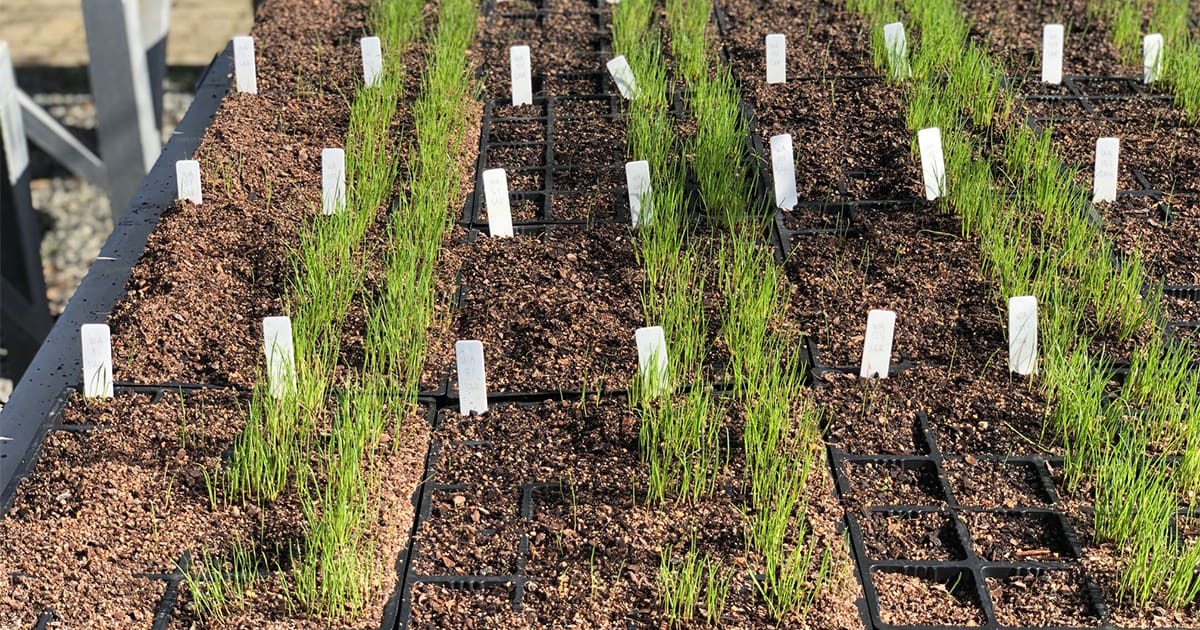
Ryegrass under intensive herbicide resistance testing (10 days after treatment) – testing standalone herbicides and mixtures of old and new chemistry.
Pre-emergent herbicides are now a central component of annual ryegrass control in no-till farming systems. Recent findings by the University of Adelaide have confirmed that populations of ryegrass from the Eyre Peninsula, SA have resistance to all the available pre-emergent herbicides, albeit some at low levels – triallate (Group J, Avadex®), prosulfocarb (Group J, Arcade®), trifluralin (Group D), propyzamide (Group D) and pyroxasulfone (Group K, Sakura®).
Metabolic cross-resistance is a serious threat to the future use of pre-emergent herbicides. For example, some of the annual ryegrass populations with widespread resistance to other herbicides already have low level resistance to some of the new chemistry coming to market.
Australian researchers have been on the front foot with testing the new chemistry prior to release to better understand the features of the new products and how they can be used in a robust integrated weed control program.
At the GRDC Updates in February 2020, at least five papers reported on research related to annual ryegrass control using new herbicides, herbicide mixtures and crop competition.
What are the new chemicals?
Dr Chris Preston (School of Agriculture, Food & Wine, University of Adelaide) provided an overview of the new pre-emergent herbicides that have been recently released or that are likely to be released in the next year or two for control of annual ryegrass.
New grass pre-em herbicides that include control of annual ryegrass:
Luximax (Group Z) http://websvr.infopest.com.au/LabelRouter?LabelType=L&Mode=1&ProductCode=86413
Luximax from BASF is a new mode of action herbicide (currently Group Z), containing cinmethylin. Luximax is a pre-emergent herbicide for annual ryegrass control in wheat, but not durum. It will provide some suppression of brome grass and wild oats. In Chris’ trials, control of ryegrass was as good as Sakura.
Mixtures with trifluralin, triallate and prosulfocarb are good and can provide some additional ryegrass control; however, mixtures with Sakura, Boxer Gold or Dual Gold® are likely to cause crop damage and need to be avoided.
Overwatch (Group Q) http://websvr.infopest.com.au/LabelRouter?LabelType=L&Mode=1&ProductCode=86427
Overwatch, active ingredient bixlozone, from FMC is a Group Q herbicide that will be available for 2021. Overwatch controls annual ryegrass and some broadleaf weeds and is registered in wheat, barley and canola. Suppression of barley grass, brome grass and wild oats can occur. The level of ryegrass control in Chris’ trials was just behind Sakura.
Mixtures with other herbicides can increase control levels and in their trials in the high rainfall zones, the mixture of Overwatch plus Sakura has been very good.
Devrinol-C (Group K) http://websvr.infopest.com.au/LabelRouter?LabelType=L&Mode=1&ProductCode=51479
Devrinol-C, active ingredient napropamide, is a Group K herbicide from UPL registered in 2019 for annual grass weed control (including annual ryegrass) in canola. Devrinol-C offers an alternative pre-emergent herbicide to propyzamide or trifluralin for canola.
Voraxor (2 x Group G) (dual use pre-em and knockdown) http://websvr.infopest.com.au/LabelRouter?LabelType=L&Mode=1&ProductCode=86452
Voraxor, from BASF, contains the active ingredients trifludimoxazin and saflufenacil, which are both Group G herbicides. Voraxor will provide broadleaf weed control and some annual ryegrass control as a pre-emergent herbicide in cereals.
Voraxor will be best used where broadleaf weeds are the main problem and annual ryegrass populations are very low. Grass pre-emergent herbicides cannot be tank mixed with Voraxor and will have to go out as a separate application.
Ultro (Group E) Not registered
Ultro, active ingredient carbetamide, from Adama is a Group E herbicide that will be available from 2021. Ultro will be registered for the control of annual ryegrass, barley grass and brome grass in all pulse crops. Although the active ingredient was registered previously in Australia for turf and pasture, this is the first product seeking registration using this active ingredient in grain production and it is a new formulation and use pattern.
BAY167 Not registered
BAY167 is a new product under development from Bayer. It will contain a new mode of action and is a pre-emergent and early post-emergent herbicide for the control of grass and some broadleaf weeds in wheat and barley. Registration is expected in 2022.
Does mixing help stave off herbicide resistance?
AHRI’s Dr Roberto Busi conducted extensive herbicide resistance testing on 140 populations of annual ryegrass in WA to demonstrate that two-way herbicide mixtures (at the highest recommended label rate) can provide highly effective control. Seed used in this research was collected from weeds found in cropped paddocks that the grower or agronomist considered problematic in terms of herbicide resistance.
The testing of single pre-emergent herbicides and mixtures showed that two mixtures – 1. trifluralin + triallate and 2. pyroxasulfone + triallate were highly effective. Survival rates were very low for the mixtures and all populations were found to be 100 per cent susceptible to these two mixtures.
In a separate screening trial Roberto tested cinmethylin (Luximax) standalone versus cinmethylin mixed with trifluralin on a reduced set of ryegrass populations. In both cases survival was very low but still the mix performed better than the standalone herbicide.
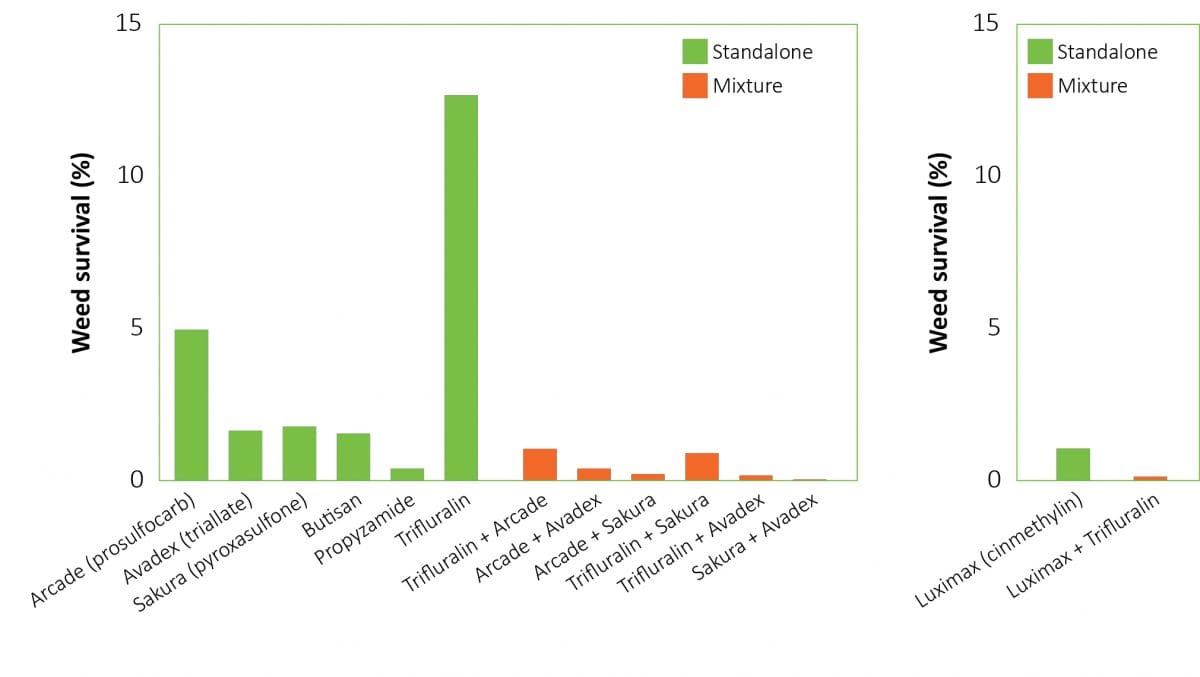
Figure 1: Left: Mean plant survival (pc) observed across 140 field populations of annual ryegrass collected in Western Australia in 2018–2019 and tested for herbicide resistance at the recommended label dose to six PRE-standalone herbicides versus six binary mixtures of the same herbicides. Right: Mean plant survival observed in a reduced set of ryegrass samples and tested for resistance to a new herbicide (cinmethylin) standalone and in a mixture with trifluralin.
Pre-emergent herbicide mixtures + crop competition = Winning
AHRI student researcher Facundo Cortese (supervised by Dr Roberto Busi, Prof. Hugh Beckie and Dr Danica Goggin), investigated the impact of applying pre-em herbicide mixtures to resistant annual ryegrass in a controlled competitive situation (pot trial).
The treatments were untreated (control), pyroxasulfone (Sakura) applied at rates of 50 and 100 g active ingredient (a.i) per ha, prosulfocarb (Arcade) applied at a rate of 2500 g a.i per ha and a mixture of pyroxasulfone (Sakura) 100 g a.i + prosulfocarb (Arcade) 2500 g a.i.
The mixture of pyroxasulfone and prosulfocarb increased the control of resistant annual ryegrass by 11pc (vs prosulfocarb alone) and 29pc (vs pyroxasulfone alone) and reduced seed production of surviving resistant plants by 88pc when compared to an untreated control. Mixing two herbicides with different modes of action significantly decreased the survival and seed production of pyroxasulfone-resistant ryegrass.
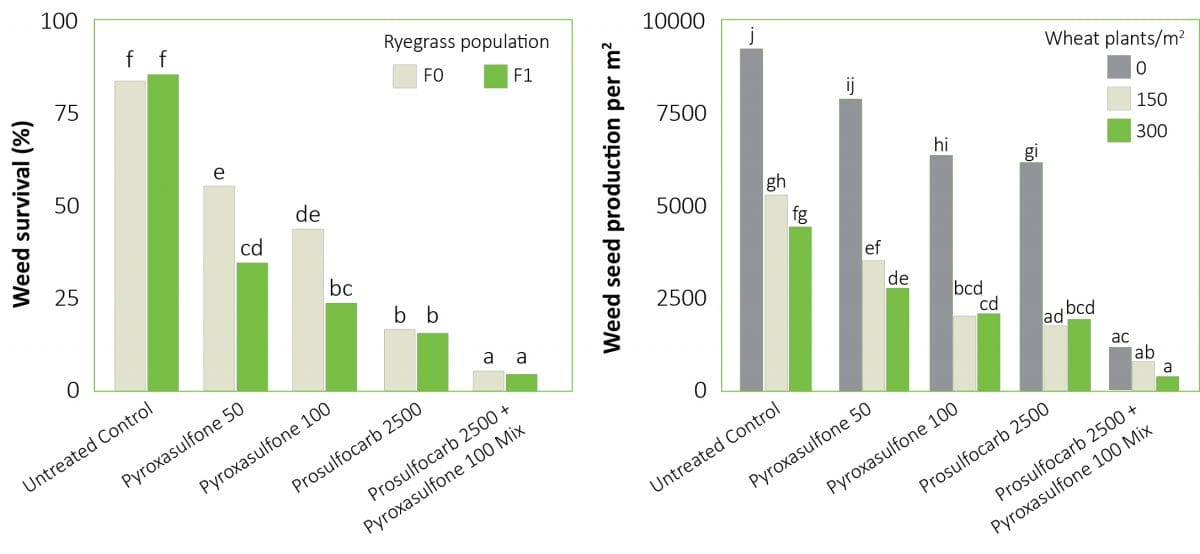
Figure 2: Left: Annual ryegrass survival (28 days after herbicide application), where light bars represent the parental resistant population (F0) and green bars represent the crosses with a susceptible population (F1). Right: Effect of crop competition and herbicide treatment on ryegrass seed production. Different letters indicate significant differences after a post-hoc Tukey test (p<0.05).
Crop competition provided an additive benefit to further reduce annual ryegrass seed production. The effect of a competitive wheat crop at 150 plants/m2 reduced seed production of resistant plants by 56%. Increasing plant density to 300 plants/m2 did not further reduce seed set or production.
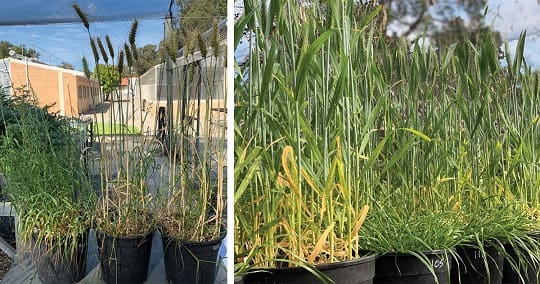
Growing a competitive crop reduces weed seed production even without herbicide. These pots are from the control treatment (no herbicide): From left to right, 0, 150 and 300 wheat plants/m2.
How to hang on to the new herbicides
None of the shiny new products offer growers a weed control panacea. They do, however, add diversity to the weed control toolbox for annual ryegrass and some extra flexibility in use patterns. With some clever planning these products can help ‘bring back’ some previously lost chemistry using the mix and rotate tactic, extending the effective life of a broader range of herbicide options. When coupled with some non-herbicide tactics the grower can regain control of herbicide resistance on their farm and operate in a low-weed situation.
WeedSmart extension agronomist Greg Condon recommends growers and agronomists first conduct testing to identify herbicide mixtures that provide effective control of the annual ryegrass present in a paddock. Then use the WeedSmart Big 6 to build a robust weed control program that includes the rotation of effective herbicides and mixtures in a diverse cropping program, double-knocking, crop competition, stopping seed set and harvest weed seed control.
Papers
Sustaining our herbicide options into the future, by Christopher Preston (School of Agriculture, Food & Wine, University of Adelaide), Feb 2020 GRDC Update https://grdc.com.au/resources-and-publications/grdc-update-papers/tab-content/grdc-update-papers/2020/02/sustaining-our-herbicide-options-into-the-future
New and old herbicides – the best integration to prolong their impact, by Roberto Busi and Hugh Beckie, Feb 2020 GRDC Update https://grdc.com.au/resources-and-publications/grdc-update-papers/tab-content/grdc-update-papers/2020/02/new-and-old-herbicides-the-best-integration-to-prolong-their-impact
Herbicide mixtures and crop competition provide excellent control of annual ryegrass and mitigate herbicide resistance, by Facundo Cortese, Dr Roberto Busi, Prof. Hugh Beckie, Dr Danica Goggin, Feb 2020 GRDC Update https://grdc.com.au/resources-and-publications/grdc-update-papers/tab-content/grdc-update-papers/2020/02/herbicide-mixtures-and-crop-competition-provide-excellent-control-of-annual-ryegrass-and-mitigate-herbicide-resistance
New chemistry – what’s new, what’s coming and how to keep them for longer, by Greg Condon, Feb 2020 GRDC Update https://grdc.com.au/resources-and-publications/grdc-update-papers/tab-content/grdc-update-papers/2020/02/new-chemistry-whats-new,-whats-coming-and-how-to-keep-them-for-longer
Source: Australian Herbicide Resistance Initiative (AHRI)
The research summarised here was made possible by the significant contributions of growers through both trial cooperation and the support of the GRDC.

HAVE YOUR SAY